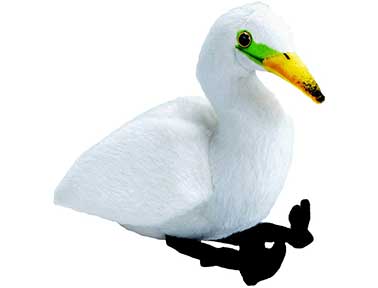


Herons belong to the
Order Ciconiiformes. The Snowy egret, Egretta thula , is a medium-size, white wading bird with a 38-inch wingspan. It is 20 inches tall. The sexes are similar. The legs and neck are long. The neck is held in an S curve in flight. The bill is thin and black. The facial skin is yellow. The legs are black; the feet are yellow. In breeding season, it has lacy plumes on its head, neck and back.
The immature Snowy is similar. It has a yellow stripe on the back of its black legs. The bill is pale and it lacks the lacy plumes.
The Snowy likes to nest near open water,
marshes and wetlands. The nesting site is selected by the male. Both parents build the nest either on the ground or in a bush. It is made of reeds and twigs. They produce a clutch of from 3 to 5 eggs. The incubation period is from 20 to 24 days and is shared by both parents. It takes the young 30 days to fledge. There is one brood produced each year.
The diet consists most of
aquatic invertebrates but they also consume reptiles, amphibians, fish and small mammals. It often feeds in groups.
The snowy egret breeds on the Atlantic, Pacific and Gulf coasts. It can also be found in some inland areas. It winters from California south to South America on the west coast and from Virginia south to the West Indies on the east coast.
Similar species include the Little Egret, which has grey facial skin and two long head plumes in breeding plumage (rare in North America); the Great White Heron, which is larger and has a thicker yellow bill; and the Cattle Egret which is smaller and has a shorter yellow bill and pale legs.
The Great Egret plush bird shown above is a Wild Republic Audubon Bird with sound. Check out Jeannie's Cottage LLC for this plush toy.



